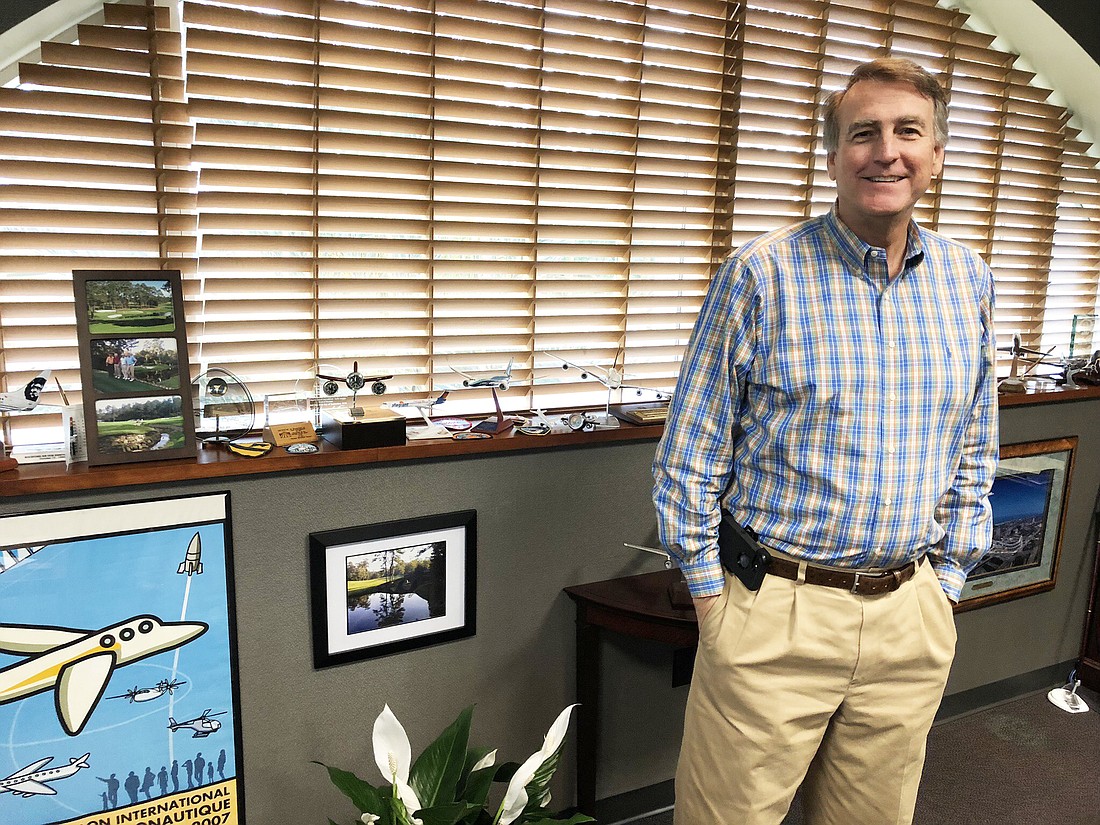
When Jacksonville Aviation Authority CEO Mark VanLoh was a child in South Dakota, the airport in Sioux Falls was his playground.
“We used to go to the airport on Sundays after church to eat. We’d go watch the airplanes. My sister and I would run up and down the concourses,” VanLoh said.
He traces his 35-year career in aviation back to a single moment on the runway in his hometown — President John F. Kennedy’s arrival on Air Force One.
“I was 4 or 5. I remember (I was) on my dad’s shoulders right up to him at the fence at the airport,” VanLoh said. “I just love aviation.”
The JAA owns and manages the area’s airports including Jacksonville International Airport, Cecil Airport/Spaceport, Jacksonville Executive at Craig Airport and Herlong Recreational Airport.
For VanLoh, the future of Jacksonville International Airport – JAX – and JAA will be defined by securing nonstop service to the West Coast, finding the first direct flight to a European destination and corporate expansion — using JAA as a jobs recruitment tool for Jacksonville.
VanLoh has been leading JAA for six months, coming from the same role at the Tulsa Aiport Authority in Oklahoma.
He earned his pilot’s license while serving in the United States Army, 1st Cavalry Division, 82nd Field Artillery Target Acquisition at Fort Hood, Texas.
After his service, he returned to the Midwest to study aviation management, business administration and economics at Minnesota State University at Mankato.
For Jacksonville to land more domestic nonstop destinations, it’s about overcoming airline logistics. Major airlines don’t want to fly over their hubs, VanLoh said.
One possible solution is working with airlines to fly into those Pacific hubs. JAA, he said, is focused on Alaska Airlines, which could fly Jacksonville passengers direct to its Seattle hub.
VanLoh’s team also is courting American Airlines to fly into The Hollywood Burbank Airport and John Wayne Airport in Orange County near Los Angeles.
During his State of the Authority speech May 30 to Jacksonville City Council, VanLoh pulled up a map of the United States, sprinkled with dots showing current nonstop flights out of JAX. The West Coast was barren.
“This is the map I’m a little concerned about,” VanLoh said. “And when I arrived in Jacksonville last year I said, ‘Where’s the West Coast?’ We are hitting all of those airlines that have headquartered trips (to the West Coast) and making that point known.”
VanLoh gave council members and Jacksonville business leaders a tip to help secure more air travel options for JAX: “If you can find 100 people per day in Jacksonville that want to go to a particular destination, the airlines will listen,” he said.
Since the cancellation of JAX’s only scheduled international flight in May — an Air Canada route to Toronto — the airport has been looking at ways to return to international destinations.
VanLoh said Air Canada’s passenger volume out of JAX was healthy. He blames the airline’s underperforming revenue on offering flyers only a 50-seat plane with no first-class option.
Comparable-sized airports like Charleston, South Carolina, have been working with British Airways to offer a direct flight to London.
Bringing in a European carrier will take an initial investment but by federal law, the money cannot come from the airport.
VanLoh said the investment should come from benefiting business groups and organizations like JAX Chamber. In Indianapolis, for example, he said business leaders collectively paid $5 million to court British Airways.
“We are a job tool with the Chamber and JAXUSA. One of the top questions someone always asks — what are your taxes like, how are your schools and do you have an airport? Can I get my employees around the world? We’re part of that discussion,” VanLoh said.
International is where VanLoh wants to take JAX. He said a market like Jacksonville has an advantage for international carriers over the larger hubs like Orlando: The profit margins are higher.
VanLoh has informed city leaders that JAA is talking to European carriers including Ireland’s Ryanair, Norwegian Air Shuttle and Icelandair.
He starts his new job at the busiest time in JAX history.
April was a record month. JAX saw 2,844 flights, up 396, or 16.18%, from April 2018.
“We started to notice we were getting busy last year when our water bill went up. Think about that. More passengers, more toilets flushing. It’s just that simple,” he said.
There are an additional 91,000 people coming through JAX terminals compared to this time last year. In response to 18 consecutive months of growth, JAA announced last month it will develop the $200 million Concourse B, with six gates and room to add six more.
“It’s to handle what we may have missed. We don’t have the gate capacity many times a day for extra flights,” VanLoh said.
There also is a focus on customer experience. Smaller upgrades, VanLoh said, are noticed by flyers.
Wear and tear from traffic means the need for new bathroom facilities and restaurant-vendor stalls, a roof replacement, and upgraded parking lots.
The concourse, expected to be completed in 2022, and customer improvements are a part of VanLoh and JAA leadership’s strategy to grow the airport on both the commercial and corporate sides of the business.
“There are several times a day where there’s no room at the inn,” VanLoh said. “We want to change that.”